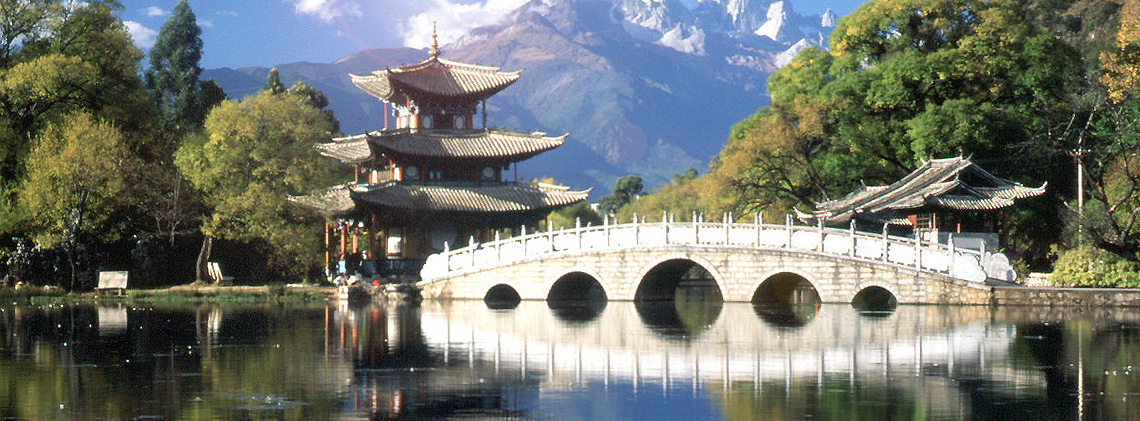
Lijiang
Splendid
Chi Culture
Topic
Lijiang
Lijiang is situated in the northwest of Yunnan province where the Yunnan-Guizhou Plateau and Qinghai-Tibet Plateau converge. Rich in history, culture, and natural beauty, Lijiang is listed as a historic city by China’s State Council.
Lijiang was named after the Jinsha River, originally known as Li River, which runs through the land. Home to twenty-two ethnic minority tribes including the Naxi, Yi, Lisu, Bai, Tibetan, and Pumi, Lijiang is also the birthplace of various tribal cultures such as the Dongba culture of the Naxi, marital customs of the matriarchal Moso people, Bimo culture of the Yi people, and Hangui culture of the Pumi people.
According to a Naxi myth, after the universe came into being, the heaven laid an egg from which the ancestor of humankind was born. Chongrenli’en, the only man who survived a disastrous deluge, married a celestial maiden called Chenhengbaobai. She gave birth to three sons who, as children, uttered the phrase “the horse is eating a turnip” in three different languages. When they grew up, the eldest son became the ancestor of the Tibetans, the second the ancestor of the Naxi, and the youngest the ancestor of the Bai. This story mirrors the multi-ethnic nature of the Lijiang region.
Inscribed on the World Heritage List in 1997, the ancient Lijiang town was constructed in the late Song and early Yuan period more than 800 years ago. Encircled by mountains, the town is inhabited mainly by the Naxi people and densely dotted with dwellings whose courtyards are filled with all kinds of plants. It was said that “passion for plants never fades in Lijiang where flowers are flourishing in every household.” At the center of the ancient town lies Sifang (four directions) Street, with seven side streets linking all the town’s roads and alleys into the shape of a spiderweb. The town used to be a busy commercial center where, as ancient people observed, “men and women were attracted from far and near… unwilling to leave until they had eaten and drunk to their heart’s content.”
The “Three Parallel Rivers,” entering the List of World Natural Heritage Sites in 2003, refer to the Jinsha River, Lancang River, and Nu River, which all originate from the Tibetan Plateau and run south parallel to each other for over 170 kilometers across the valleys of Hengduan Mountains.
Legend has it that the three rivers were sisters, with Jade Dragon and Haba their two elder brothers. Having their respective lovers already, the three sisters decided to flee together so that they did not have to be married to three men of the west as was arranged by their parents. Jade Dragon and Haba were sent by their parents to intercept the sisters in the east. Lancang and Nujiang (personified versions of the rivers), fearing to be caught, ran southwards. After parting with her two elder sisters at Shigu town, Jinsha (the personified Jinsha River) sharply turned east towards her beloved Dragon Prince of the Eastern Sea. Having sneaked past Haba as he dozed off, Jinsha turned back to bid farewell to her sisters again, thus forming the First Bend of the Yangtze River. After that, Jinsha (i.e., the Yangtze) River flowed freely towards the East China Sea, while the Lancang River and Nu River kept flowing south, across Burma, Vietnam, Laos, and Thailand, into the Indian Ocean.
The “Three Parallel Rivers” covers an area of some 40,000 square kilometers with an elevation change of up to 6,000 meters. This brings about the highly variable climate depicted in the saying “four seasons in one day, different weather within one mile.” The variable climate gives rise to diversified species. Harboring more than 25% of China’s animal species, among which are many endangered ones, the “Three Parallel Rivers” ranks among the tops in the world for its abundant plant species.
Included by the United Nations Educational, Scientific and Cultural Organization in 2003 in the Memory of the World Register, the ancient Naxi Dongba literature was the holy scripture of the primitive Dongba religion. The manuscripts, written in pictographs, demonstrate the ancient wisdom of the Naxi people with their social organization, morality, science, art, and other aspects.
Lijiang was not only an important passage on the “Ancient Tea-Horse Road,” but also a vital stop on the only land route through which international relief entered China during the Second World War. Lijiang’s diversified cultural environment, formed through abundant materials and cultural exchanges, presents multi-faceted cultural attractions.



